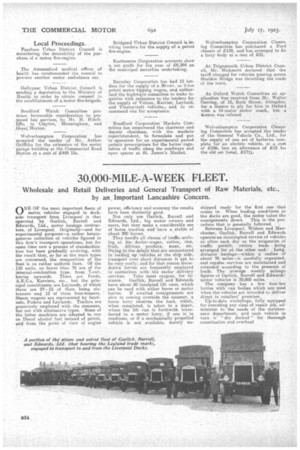30,000-MILE-A-WEEK FLEETS
Page 8

If you've noticed an error in this article please click here to report it so we can fix it.
Wholesale and Retail Deliveries and General Transport of Raw Materials, etc., by an Important Lancashire Concern.
oNE OF the most important fleets of motor vehicles engaged in dockside transport from Liverpool is that operated by Garlick, Burrell and Edwards, Ltd., motor haulage contractors, tyf Liverpool. Originally—and for experimental purposes—a rather heterogeneous collection ot vehicles figured in this firm's transport operations, but for some time now a process of standardization has been gradually evolving, with the result that, se fax as the main types are concerned, the composition of the fleet is on rather uniform lines. Of the _ 110 units, no fewer than 70 are of the internal-combustion type, from 7-cwt. lorries upwards. Mere are Fords, A.E.Q.s, 'Carriers, etc., but the principal constituents are Leylands, of which there are 27-15 of them being sixtonners and 12 of them four-tonners. Steam wagons are represented by Sentinels, Fodens and Leylands. Trailers are generously employed with the steamers, but not with alternative types. Some of the latter machines are adapted to run on Discol alcohol fuel instead of petrol, and from the point of view of engine
power, efficiency and economy the results have been distinctly good.
Not only are Garlick, Burrell and Edwards, Ltd., big motor owners and users, but they make a considerable use of horse tractiou and 'have a 5table of about 200 horses.
• They handle all classes of traffic arriving at the docks—sugar, cotton, rice, fruit, African produce, meat, etc. Owing to the delays that are encountered in loading up vehicles at the ship side, transport over short distances is apt to be very costly, and for that reason horsedrawn lorries are frequently employed in connection with the motor delivery
services. Take meat cargoes, for instance. Garlick, Burrell and Edwards have about 50 insulated lift vans, which can be used with either horse or motor
lorries. If awaited consignments are slow in coming override the steamer, a horse lorry receives the load, which, when completed, is taken to a depot, where the lift van is forthwith transferred to a motor lorry, if one is• in readiness, or if a mechanically propelled vehicle is not available, merely un
shipped ready for the first one that comes in. When loading conditions at the docks are good, the motor takesthe consignments direct. This is the procedure that is generally followed. .. Between Liverpool, Widnes and Manchester, Garlick, Burrell and Edwards operate an interrupted service of vehicles as often each day as the exigencies of traffic permit, return loads being arranged for at the other end:• Longdistance haulage—within a -radius of about 70 miles—is carefully organized, and regular services are maintained and extended according to the pressure of loads. The average weekly mileage figures of Garlick, Burrell and Edwards' motor vehicles is 30,000 miles.
• The company has a few four-ton lorries with van bodies, which are used when the vehicles are intended to deliver direct to retailers' premises. UP-to-date workshops, fully equipped for executing any class of repair job, administer to the needs of the maintenance department, and each vehicle in turn is "dry docked " for thorough examination and overhaul




























